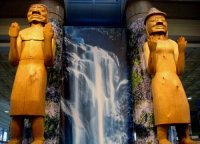First Nations Consultation

On February 18, 2009, the B.C. Court of Appeal issued two decisions which have significant implications for BC Hydro's role in First Nations consultation: the Carrier Sekani Tribal Council v. British Columbia Utilities Commission (2009 BCCA 67), and the Kwikwetlem First Nation v. British Columbia Utilities Commission (2009 BCCA 68).
Q&A: Common questions about the consultation process
Common questions about BC Hydro's role in First Nations consultation for current and future power acquisition activities following two B.C. Court of Appeal decisions in 2009.
1. How is BC Hydro approaching First Nations consultation on Independent Power Producer ("IPP") projects from which it wishes to purchase power?
BC Hydro will be assessing the adequacy of First Nations consultation prior to concluding an Electricity Purchase Agreement ("EPA"). Previously, BC Hydro examined IPPs' consultation with First Nations from a risk assessment perspective.
2. How is this different than BC Hydro's previous practices with regard to First Nations consultation on its power acquisitions?
Prior to these B.C. Court of Appeal decisions, BC Hydro has considered IPPs' consultation with First Nations as part of its risk assessment in evaluating IPPs' proposals. In particular, BC Hydro considered the status of an IPP's consultation with First Nations to the degree that it could affect securing the necessary land tenure and other permits from the Crown and successful development of the project.
3. How will this impact BC Hydro's current power acquisition processes?
As each of BC Hydro's current acquisition processes is at a different stage, BC Hydro is determining what impact the new approach to consultation will have on each acquisition process. Once determined, BC Hydro will provide an update on its website and to IPPs as appropriate.
4. How will this affect future call processes?
With future calls for power, BC Hydro has the opportunity to incorporate the new requirements for First Nations consultation at the outset into all elements of call design.
5. How will BC Hydro's new role impact the Clean Power Call?
BC Hydro will be assessing the adequacy of First Nations consultation prior to entering into an EPA for the sale of power to BC Hydro. Further information or action may be required from or by those proponents to enable BC Hydro to complete that assessment. BC Hydro will contact proponents if further information is required.
6. When does BC Hydro expect to award EPAs in the Clean Power Call in light of these new requirements?
BC Hydro is committed to ensuring as smooth and expedient a process as possible, while ensuring that an assessment of First Nations consultation has taken place. BC Hydro intends to complete its assessment of First Nations consultation and post-proposal discussions as required. It will then undertake internal approvals of any EPA awards, and intends to begin notifying any successful proponents in December 2009.
7. How will Bioenergy Call Phase II be affected?
As Phase II of the Bioenergy Call is still in relatively early stages, BC Hydro has the ability to incorporate new requirements with respect to First Nations consultation into call documents and timelines. BC Hydro will update the Bioenergy Phase II website as new information on both the Community-Based Biomass ("CBB") and Biomass Projects ("BP") streams becomes available.
8. What about the Standing Offer Program (SOP)?
The Standing Offer Program is unique in that it is an ongoing acquisition process for projects up to 10 megawatts and requires proponents to apply with permits already in place. As a result, and depending on the specific circumstances of the project, there is a possibility that the IPP has provided information regarding First Nations consultation to the Crown. However, BC Hydro will still assess the adequacy of consultation before offering an EPA to the applicant. For current SOP applicants, BC Hydro will work with the applicants to complete this assessment.
9. How will the Haida Gwai Request For Proposals ("HG RFP") be impacted?
BC Hydro received input from the Haida Nation, other First Nations and stakeholders and is continuing to design the HG RFP. BC Hydro has the ability to incorporate new requirements with respect to First Nations consultation into call documents and timelines.
10. In many cases, IPP project developers have already gone through an extensive permitting process with the Crown agencies before an EPA was signed, and those agencies have assessed the adequacy of consultation undertaken for the project. Why is BC Hydro then assessing the adequacy of consultation?
BC Hydro's decision to assess the adequacy of First Nations consultation prior to entering into an electricity purchase agreement is based on recent B.C. Court of Appeal decisions.
When assessing adequacy of consultation, BC Hydro will seek to identify what, if any, other agencies may have already assessed the adequacy of consultation. BC Hydro's review of the evidence provided during the permitting process may satisfy BC Hydro's requirements, but if not, BC Hydro may require additional evidence to support an IPP proposal. BC Hydro will not assess the determinations with respect to the adequacy of consultation undertaken by other Crown agencies.
11. How will BC Hydro assess the adequacy of that First Nations consultation? What factors will be considered?
BC Hydro will assess the adequacy of First Nations consultation undertaken by IPPs in much the same way as any Crown agency. BC Hydro will consider a number of factors when assessing First Nations consultation, which may include the following:
- Information on how the IPP determined which First Nations to consult.
- Information on the potential degree of impact from a project on aboriginal rights and title, and information on how this assessment was reached.
- Information on the level of consultation and potential avoidance, mitigation or accommodation required for each impact and how this was, or will, be undertaken by the IPP as evidenced by consultation reports, logs, impact benefit agreements, letters of support, correspondence and any other material submitted demonstrating consultation.